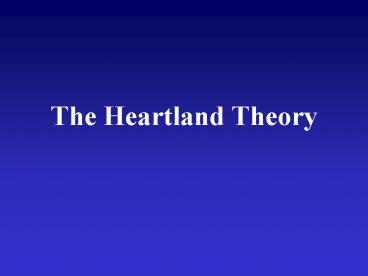The Heartland Theory - PowerPoint PPT Presentation
1 / 16
Title:
The Heartland Theory
Description:
The Heartland Theory What is the theory? a theory of geopolitical relations proposed by Halford Mackinder after WWI whoever controls Eastern Europe controls the ... – PowerPoint PPT presentation
Number of Views:637
Avg rating:3.0/5.0
Title: The Heartland Theory
1
The Heartland Theory
2
What is the theory?
- a theory of geopolitical relations proposed by
Halford Mackinder after WWI - whoever controls Eastern Europe controls the
World Island (Asia, Europe and Africa) and then
ultimately the entire world
3
(No Transcript)
4
Why Eastern Europe?
- at the time the vast resources of Eastern Europe
were considered incredibly important (coal,
farmland, and lots of flat land for expansion,
urbanization) - according to the theory, once a country controls
the Heartland, it will seek to control the Inner
Crescent - Africa and Asia (the rest of the World
Island)
5
- it will do this by first gaining control of the
warm water ports of western Europe, which will
give it control over sea lanes and the coasts of
Asia and Africa
6
- eventually the Americas and Oceania would
collapse and succumb to the overwhelming power of
the country controlling the World Island - and so, control of Eastern Europe was considered
crucial
7
How valid is the theory?
8
Against
- it did not take into consideration future rise of
the USA as a major international power -
militarily and economically - it did not foresee the rise of aircraft as a
major military weapon - it did not foresee nuclear deterrence, nor
intercontinental ballistic missiles
9
In support
- the USSR did try to expand out from the Heartland
- it dominated the countries of Eastern Europe
militarily and economically after WWII - NATO was the military alliance that was created
to stop this expansion - Warsaw Pact and COMECON were alliances of the
Soviet bloc
10
- Hungary 1956, Czechoslovakia (Prague Spring
1968), Poland 1980s are examples of how the
Soviet government tolerated no independence - USSR sponsored communist parties outside Eastern
Bloc and tacitly supported terrorist movements to
undermine the security of western nations (e.g.,
IRA (Britain), Red Brigades (Italy), Red Army
(Japan)
11
- Cuba, Vietnam and Afghanistan can also be seen as
efforts by the USSR to expand beyond the
Heartland - they also supported a variety of governments
throughout the developing world
12
Containment
- Containment was the West's response to Soviet
expansionist threats as seen at first in the
context the Heartland theory - NATO (North Atlantic Treaty Organization USA,
Canada, Great Britain), SEATO (South East Asia
Treaty Organization - Philippines, Pakistan,
Thailand, Australia ), and CENTO (Central Treaty
Organization Turkey, Iraq, Iran, Pakistan) were
the military alliances set up, mainly through US
pressure, to carry out the policy of containment.
Seato and Cento are no more.
13
- Basically, Soviet expansion was contained to the
Heartland by the threat of first strike nuclear
retaliation if the Soviets invaded any allied
member or threatened the security of any member
nation - Soviet response to containment was to leap-frog
Western Europe and to establish pro-Soviet bases
(countries) elsewhere - Angola, Vietnam,
Nicaragua, Cuba
14
- the Soviet response to containment was itself
contained by the further threat of nuclear war -
especially the case with Cuba (and the 1962
Missile Crisis)
President John F. Kennedy, US President during
1962 Cuban Missile Crisis
15
This theory has been modified (twisted) to fit a
smaller scale like a country. The theory has also
become an economic one (remember Wallerstein). In
Canada we have the Heartland-Hinterland theory.
The Heartland being southern Ontario and Quebec.
Where all the industry, manufacturing, finances
and other major functions are located. The
Hinterland is the rest of Canada that supplies,
labour and raw materials to the Heartland. The
USA considers its Heartland the agricultural
heart of the country states like Oklahoma,
Arkansas, Missouri and Kansas are considered the
Heartland.
16
The End!































